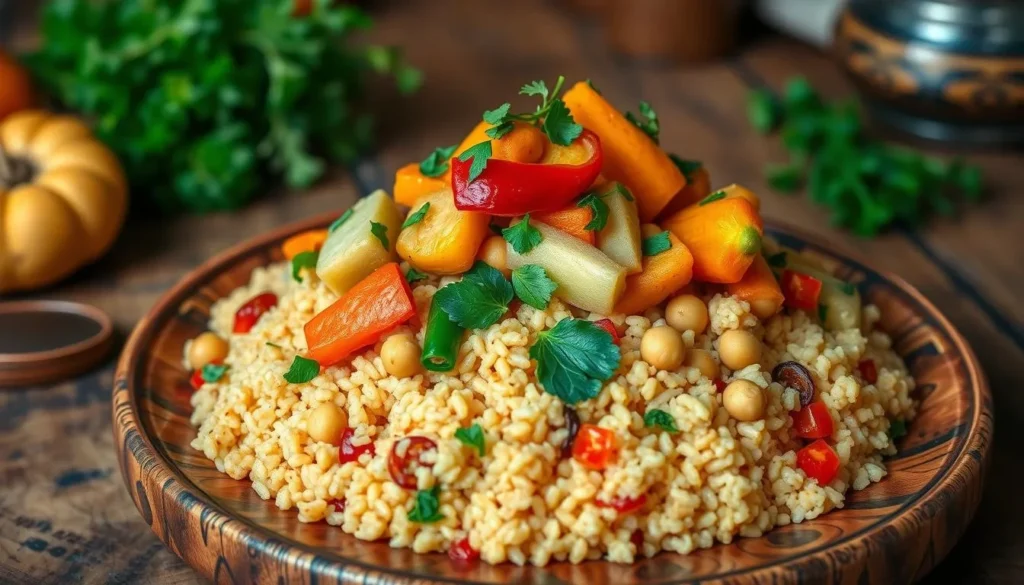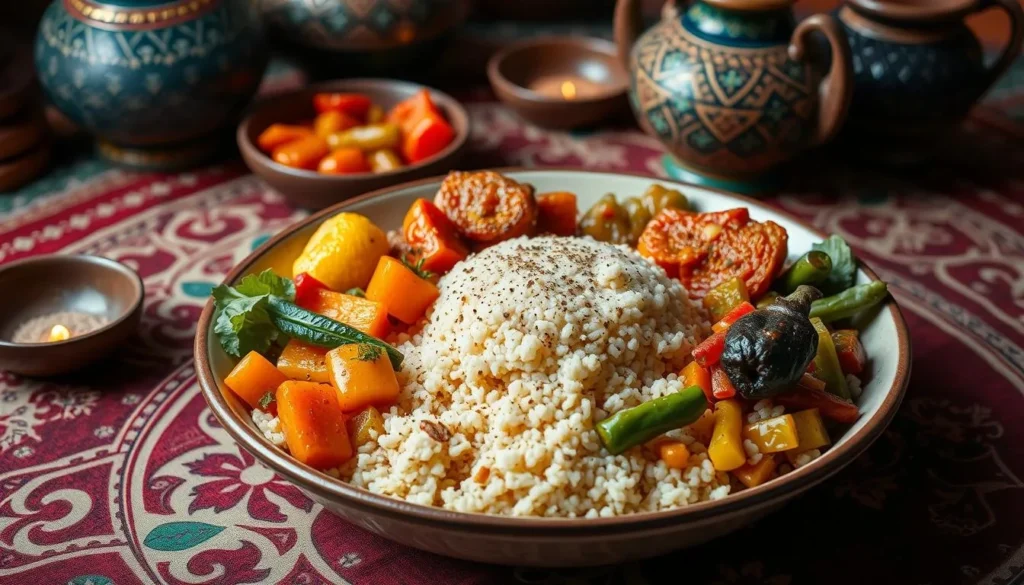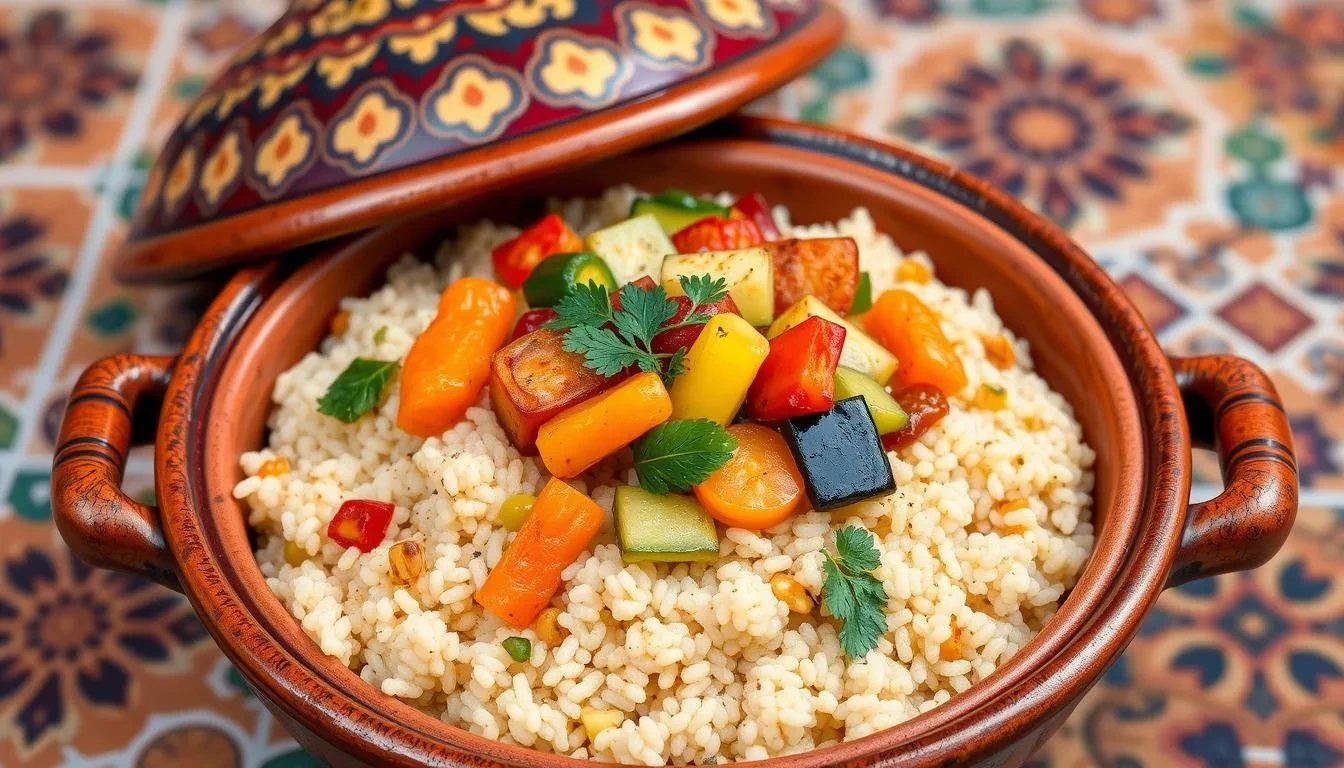Moroccan Couscous
The smell of spices and the colors of fresh veggies take me to Marrakech’s markets. There, the smell of North African food is everywhere. Making this Moroccan couscous with seven veggies reminds me of Morocco’s warmth and kindness.
This dish is more than food. It’s a celebration of tastes, a time to bring people together. It’s a way to enjoy Morocco’s rich food culture.
It is easy to see why people worldwide love this world-famous Moroccan couscous! High in grains and veggies, fiber, protein, and vitamins. Delicious and wholesome, you only need 25 minutes of prep time & 13 ingredients.
Whether you adore couscous and are used to Moroccan cuisine or have never eaten it, this recipe will wow you. This will leave you hungry for more.
Table of Contents
Ingredients for Moroccan Couscous

To create the perfect Moroccan couscous, you’ll need fresh vegetables, aromatic spices, and a few pantry staples:
Vegetables:
- 2 carrots, peeled and sliced
- 2 zucchinis, cut into chunks
- 2 turnips, peeled and quartered
- 1 large potato, peeled and diced
- 1 red bell pepper, chopped
- 1 medium onion, finely chopped
- 1 cup cooked chickpeas
Spices and Flavorings:
- 1 tsp paprika
- 1 tsp ground cumin
- ½ tsp turmeric
- 1 tsp ground coriander
- 2 cloves garlic, minced
- 1-inch piece of ginger, grated
- Salt and pepper, to taste
- 2 tbsp olive oil
- Juice of 1 lemon
Couscous Base:
- 1½ cups whole wheat couscous
- 1½ cups hot vegetable or chicken broth
- 2 tbsp butter or olive oil
- ¼ cup golden raisins
- ¼ cup toasted almonds or pine nuts
- Fresh parsley, chopped, for garnish
Step-by-Step Preparation Guide
- Cook the Vegetables
- Heat olive oil in a large pot or skillet over medium heat. Sauté the onions, garlic, and ginger until fragrant.
- Add carrots, zucchini, turnips, potato, and red bell pepper. Stir in paprika, cumin, turmeric, coriander, salt, and pepper.
- Pour enough water or broth to cover the vegetables halfway. Simmer on low heat for 20-25 minutes, or until the vegetables are tender.
- Stir in the chickpeas and cook for an additional 5 minutes.
- Prepare the Couscous
- Place couscous, butter, and golden raisins in a large bowl.
- Pour hot broth over the couscous, cover, and let sit for 10 minutes.
- Fluff with a fork to separate the grains and achieve a light, airy texture.
- Assemble the Dish
- Spread the couscous on a large serving platter.
- Arrange the vegetables and chickpeas on top, creating a colorful display.
- Drizzle with lemon juice and garnish with toasted nuts and fresh parsley.
Kitchen Tools and Equipment Needed
General kitchen tools are needed to prepare tasty couscous side dishes. The right tools help cooking go smoothly, whether preparing the best authentic Moroccan couscous or exploring new recipes. They also ensure impressive results every time.
First, you’ll need an oversized skillet or saucepan with a lid that fits tightly to the skillet. So this is what will be used to cook the couscous and allow vegetables and spices to bloom. You can use a baking sheet to toast the nuts or seeds. It brings crunch and taste to your dish.

You’ll also need mixing bowls of different sizes. They help you mix and combine the ingredients of your couscous dish. Don’t forget measuring cups and spoons. They’re key for getting the right amounts of couscous, liquids, and spices for balanced flavors.
- Large skillet or saucepan with lid
- Baking sheet for toasting nuts or seeds
- Mixing bowls in various sizes
- Measuring cups and spoons
- Fork for fluffing couscous
- Sharp knife for chopping vegetables
A rice cooker is not essential but can be very helpful. It’s great for making couscous side dishes often. The rice cooker’s automatic settings make cooking couscous easy and ensure it’s always fluffy.
With these tools and equipment, you’re ready to make a variety of couscous side dishes. They’ll surely impress your family and guests.
The Cultural Heritage
Moroccan couscous is deeply rooted in North Africa’s rich cultural traditions. It has a fascinating history that goes back centuries. This dish shows the culinary genius and skill of the Berber people.
- Origins and Historical Significance
The history of Moroccan couscous starts in the 7th century AD. It was a staple for the Berber tribes of the region. Over time, it became a key part of Moroccan cuisine, loved across North Africa.
- Traditional Preparation Methods
Making Moroccan couscous is a hard, handmade process. The semolina grains are sifted, steamed, and rolled. This makes the couscous small and light.
This careful method keeps the couscous’s delicate texture. It also lets it soak up the flavors of vegetables, spices, and sauces.
- Cultural Importance in Moroccan Cuisine
Couscous is a big part of Moroccan culture. It is commonly served during social events and festivals, such as religious holidays or family festivities. And it symbolizes hospitality and community.
Cultural Significance: Moroccan couscous involves the use of spices, nuts, and dried fruits, which reflect the region’s profound culinary influence. It does an excellent job of representing Mediterranean-style dishes with flavourful couscous, the globally loved types.

Health Benefits and Nutritional Value
Whole wheat couscous is a nutritious and versatile grain. It offers many health benefits. This traditional North African staple is full of fiber, protein, and vitamins and minerals. Adding couscous to your meals can make them healthier.
Couscous is high in fiber, with nearly 8% of the daily fiber intake in one serving. This helps with digestion and prevents constipation. It also slows down how carbs are absorbed, which is good for people with diabetes.
Couscous is a good source of carbs for energy. It also has protein for muscle growth and repair. Plus, it has vitamins A, selenium, and potassium. These support eye health, the immune system, and heart health.
| Nutrient | Amount per Serving | Percentage of Daily Value |
|---|---|---|
| Calories | 176 kcal | – |
| Carbohydrates | 36.4 g | 13.2% |
| Protein | 5.95 g | 11.9% |
| Fiber | 2.2 g | 7.9% |
| Selenium | 78.5 μg | 78.5% |
| Niacin (B3) | 1.53 mg | 9.6% |
| Pantothenic Acid (B5) | 1.16 mg | 11.6% |
| Iron | 0.597 mg | 3.3% |
| Copper | 0.064 mg | 7.1% |
| Manganese | 0.132 mg | 5.7% |
Couscous is great for a healthy diet. It’s packed with nutrients. Adding it to your meals can make them more nutritious. Whether it’s a healthy couscous meal or a couscous protein bowl, it’s a great choice.
Trusted Sources: For more information on the benefits of couscous, Vegetables, see the National Institutes of Health and the Mayo Clinic.
Variations and Modern Adaptations
Traditional Moroccan couscous with seven vegetables is a classic. But, there are many variations and modern twists. These changes cater to different tastes and trends. You can find vegetarian, gluten-free, and regional versions of this dish.
- Vegetarian Options
For a meatless couscous, use mushrooms, tofu, or artichoke hearts instead of meat. Adding extra feta cheese makes it creamy. These vegetarian recipes are just as tasty as the original.
- Gluten-Free Alternatives
Couscous is usually made from wheat, but you can find gluten-free options. Quinoa couscous or gluten-free couscous brands are great choices. These alternatives can be cooked just like the traditional dish.
- Regional Variations
In Moroccan, couscous recipes vary by region. Moroccan couscous often includes cumin, coriander, and cinnamon. Moroccan versions might use harissa for a spicy flavor.
Whether you like traditional Moroccan couscous, a vegetarian version, or gluten-free, there’s something for everyone. Try these different recipes to find your favorite way to enjoy couscous.
Serving Suggestions and Accompaniments
Stewed Moroccan couscous is a delicious dish that goes well with all kinds of savory accompaniments. This is fabulous, hot or cold! Couscous works well for several sides and entrés.
Pair that with tagines, stews, or grilled meats for a traditional Moroccan-influenced meal, and you have couscous. This rich North African staple includes meat—and would you believe it—some of the best couscous on this side of the ocean; it is nutty, fluffy, and a great accompaniment to the rich sauces and melt-in-your-mouth proteins.
Want to lighten things up? Couscous complements a fresh, hearty vegetable May-side. Pair it with grilled corn or roasted asparagus, or put it into an air fryer with baby potatoes for a rainbow-colored Mediterranean buffet. Garlic butter green beans are also delicious and served with it or as a simple salad.
From couscous side dishes to Mediterranean couscous dishes, the options are limitless. Try new flavors and cooking methods to discover your new cherished matches.
| Recommended Couscous Accompaniments | Cuisine |
|---|---|
| Beef and Broccoli | Chinese |
| Glazed Salmon | Mediterranean |
| Haddock | Seafood |
| Orange Chicken | Asian |
| Tofu Curry | Indian |
| Zuppa Toscana | Italian |
| Lamb Stew | Middle Eastern |
| Cola Chicken | American |
No matter what you choose to serve alongside your Moroccan couscous, it’s sure to make your meal better. Its delicious, nutrient-dense qualities will elevate your dish.

Make-Ahead and Storage Tips
Enjoying couscous dishes doesn’t have to end after one day. You can keep the flavors alive with smart storage and meal prep. This way, you can enjoy couscous for days to come.
- Proper Storage Methods
Keep leftover couscous in an airtight container in the fridge for 3-4 days. For longer storage, freeze it for up to 4 months. Just thaw it in the fridge before reheating.
- Reheating Guidelines
Reheating couscous is easy. Put it in a microwave-safe dish with a bit of broth or water. Heat in 30-second bursts until warm. Or, reheat it on the stovetop over low heat, stirring often.
Meal Prep Strategies
- Prepare couscous ahead and portion it into containers for quick meals all week.
- Store couscous salad or dish with dressing or toppings separate. This keeps it from getting soggy.
- For big events, make couscous parts ahead and assemble just before serving. This keeps it fresh and flavorful.
Follow these tips for making couscous ahead and storing it. You’ll enjoy healthy, tasty couscous dishes anytime, without losing flavor or texture.
Quick and Easy Weeknight Couscous Recipes
Couscous is a favorite in many homes. It’s great because it’s tasty and healthy. You can make quick meals like salads or main dishes with it.
- Couscous with Rotisserie Chicken and Roasted Veggies
Make a tasty meal with a rotisserie chicken, roasted veggies, and couscous. It’s ready in 30 minutes. It’s perfect for a quick, healthy dinner.
- Mediterranean Couscous Salad
This salad is bright and full of Mediterranean flavors. It’s great for a light dinner. Mix cooked couscous with feta, tomatoes, olives, and a lemon-garlic dressing.
- Couscous with Shrimp and Pesto
This dish is packed with protein. It has sautéed shrimp and basil pesto. It’s both healthy and tasty.
| Dish | Prep Time | Cook Time | Total Time | Servings |
|---|---|---|---|---|
| Couscous with Rotisserie Chicken and Roasted Veggies | 20 mins | 10 mins | 30 mins | 2 |
| Mediterranean Couscous Salad | 15 mins | 10 mins | 25 mins | 4 |
| Couscous with Shrimp and Pesto | 20 mins | 15 mins | 35 mins | 2 |
These couscous recipes are tasty and healthy. They’re perfect for busy weeknights. Try them out and see how they become favorites in your home.
Seasonal Adaptations and Ingredients
If you include seasonal produce in your couscous recipes, they will taste great and be more beneficial. Let seasonal local produce inspire you seasonally throughout the year for various couscous with vegetable recipes that are tasty and healthy.
Spring — bright green couscous with asparagus and fresh peas. We have some tremendous juicy tomatoes and zucchini in the summer to help brighten things up, which can get a somewhat warm and earthy taste with fall flavors – butternut squash or apples—root veggies with a warm meal of Kale from winter or spinach.
Adjust spices and aromatics to match the season’s ingredients for a balanced flavor. With creativity and an eye for fresh produce, couscous can be enjoyed all year. It celebrates the flavors of each season.
FAQ
What is the total preparation time for the Moroccan couscous recipe?
The Moroccan couscous recipe takes about 25 minutes to prepare.
How many calories are in a serving of the Moroccan couscous dish?
A serving of Moroccan couscous has about 200 calories.
How many ingredients are used in the Moroccan couscous recipe?
The recipe uses 13 key ingredients.
How much fiber is in a serving of the Moroccan couscous dish?
Each serving has 5 grams of fiber.
What is the Vitamin C content per serving of the Moroccan couscous?
It has 20% of the daily Vitamin C value per serving.
Where did couscous originally come from?
Couscous comes from the Berbers in the 7th century AD. It’s a staple in North Africa, especially in Morocco, Algeria, and Tunisia.
What is the cultural significance of couscous in Moroccan cuisine?
Couscous is key in Moroccan culture. It’s served at social events and holidays. It’s made for Friday lunch after prayers, showing hospitality and community.
What are the key ingredients in the Moroccan couscous recipe?
Key ingredients are whole wheat couscous, pine nuts, butter or oil, shallots, salt, pepper, cumin, broth, golden raisins, parsley, lemon juice, and olive oil. Carrots, zucchini, turnips, and chickpeas are also used.
What essential tools are needed to make the Moroccan couscous dish?
You’ll need a large skillet or saucepan, a baking sheet for nuts, mixing bowls, measuring cups and spoons, a fork, and a sharp knife. A rice cooker is optional.
What are some tips for perfectly cooking the couscous?
Toast nuts at 350°F for 5-7 minutes. Cook shallots in butter, add spices and broth, then boil. Remove from heat, add couscous, and let it sit for 10 minutes. Fluff with a fork to avoid clumps.
What are some variations and adaptations for the Moroccan couscous recipe?
You can use vegetarian proteins like mushrooms, tofu, or artichoke hearts. Try gluten-free options like quinoa or gluten-free couscous. Regional flavors may vary based on local tastes and ingredients.
How should the Moroccan couscous be served and what are some good accompaniments?
Serve Moroccan couscous hot or cold. It goes well with tagines, grilled meats, or vegetable stews. It also pairs with grilled corn, air fryer baby potatoes, roasted asparagus, or garlic butter green beans.
How should the Moroccan couscous be stored and reheated?
Store leftover couscous in an airtight container in the fridge for 3-4 days or freeze for up to 4 months. Reheat in the microwave or enjoy cold. Prepare components separately for meal prep.
Savour the Sweet and Savory Magic of Moroccan Beef Tagine with Dried Apricots and Almonds!
Looking for a taste of Morocco’s most iconic flavours? Experience the perfect balance of sweetness and spice with the Moroccan Beef Tagine with Dried Apricots and Almonds! Tender beef, sweet apricots, and crunchy almonds come together in a rich, aromatic sauce that will transport you straight to a Moroccan kitchen. Discover the full recipe here!
Did you make this recipe?
There are no reviews yet. Be the first one to write one.

